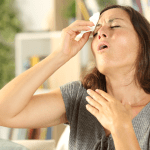Menopause is often referred to as “the change of life” for good reason. It marks the end of a woman’s reproductive years and ushers in a new phase of life. This natural biological process typically occurs in a woman’s late 40s or early 50s and is diagnosed after 12 consecutive months without a menstrual period. Menopause is a significant life transition that involves a variety of physical and emotional changes, many of which are driven by fluctuations and eventual decline in the levels of key hormones, particularly estrogen.
Overview of Breast Changes During Perimenopause
Perimenopause is the transitional period leading up to menopause, during which women may begin to notice changes in their breasts. These changes can include increased tenderness and pain, a shift in size and shape, and the development of lumps. The hormonal roller coaster of perimenopause, with its unpredictable estrogen and progesterone levels, can lead to irregular cycles and unexpected breast soreness. As estrogen levels drop, the glandular tissue in the breasts shrinks, leading to a decrease in breast density and an increase in fatty tissue, which can result in sagging. Some women may experience an increase in breast size, often due to hormone-related weight gain.
The Importance of Recognizing Normal vs. Abnormal Changes
While many breast changes during perimenopause are normal, it’s crucial to distinguish between those and signs that may indicate a more serious condition. Normal changes can include tenderness, moderate fluctuations in size, and the presence of benign cysts or fibrocystic changes. However, certain symptoms should prompt immediate medical attention. These include the appearance of a new lump or a firm area, changes in nipple appearance such as inversion, skin alterations like redness or dimpling, and unexplained swelling or shrinkage of the breast, particularly if it’s only on one side. Understanding these differences empowers women to seek appropriate care and maintain breast health during this transformative stage of life.
Breast Tenderness and Pain
Hormonal Fluctuations and Breast Sensitivity
As women approach menopause, they often experience a range of physical changes, including alterations in breast sensitivity and tenderness. This discomfort is primarily due to hormonal fluctuations that occur during perimenopause. Estrogen and progesterone levels can spike up and down unpredictably, leading to symptoms of tenderness, burning, or soreness. These hormonal changes can also cause the breast ducts to enlarge and the milk glands to grow, resulting in swollen and tender breasts. It’s important to understand that while breast pain is common during this life transition, it is typically benign and often transient.
Effective Management Strategies for Discomfort
There are several strategies that can help manage breast tenderness during menopause:
- Supportive Bras: Wearing a well-fitted bra, especially a sports bra, can provide significant relief from breast pain. A study found that 85% of women with breast pain gained relief from wearing a well-fitted sports bra.
- Warm Compresses: Applying heat to the painful area can soothe inflamed tissues and improve circulation, helping to alleviate discomfort.
- Reducing Caffeine: Cutting back on caffeine may help dampen the effects of breast tenderness, as caffeine can exacerbate menopause symptoms.
- Over-the-Counter Pain Relievers: Medications such as ibuprofen or acetaminophen can be effective in reducing inflammation and pain.
- Lifestyle Changes: Quitting smoking, cutting back on sodium, and maintaining a healthy weight can also contribute to reducing breast discomfort.
It’s essential to consult with a healthcare professional before starting any new treatment or making significant lifestyle changes.
By the way, something for you, a little gift!!!
I am just in the middle of publishing my book. It’s about How women can balance their hormones. One part is about food and diet, of course.
Follow this link and enter your email.
I will send you this part of the book for free once the book is published. It has many concrete, practical tips and recipes and will help you feel better during menopause or times of Big hormonal fluctuations.
Annette, Damiva Lead for Health & Wellness

When to Consult a Healthcare Professional
While breast tenderness is rarely an early sign of breast cancer, it is crucial to consult a healthcare professional if you experience severe or persistent pain, or if you notice any new or unusual symptoms. These may include:
- A lump or thickening in or near the breast or under the arm
- Nipple discharge or changes, such as an inverted nipple
- Changes in the skin of the breast, such as redness, dimpling, or puckering
- Unexplained swelling or shrinkage of the breast, particularly if it’s only on one side
Additionally, it’s important to discuss the frequency of mammograms with your doctor, as guidelines vary based on age and individual risk factors. Early detection and evaluation of any breast changes are key to maintaining breast health during and after the menopause transition.
Alterations in Breast Size and Shape
The Role of Estrogen in Breast Tissue Composition
Estrogen plays a pivotal role in the composition and appearance of breast tissue. During the reproductive years, this hormone maintains the hydration and elasticity of connective tissue, contributing to the firmness and shape of the breasts. As women approach menopause, estrogen levels decline, leading to a process known as “involution.” This process involves the shutting down of milk glands, which are then replaced by fat. This shift in tissue composition can result in changes in breast size and shape, often leading to an increase in breast size and a softer, less dense texture.
Exercise and Its Impact on Breast Appearance
Regular exercise can have a significant impact on breast appearance during menopause. As the body undergoes hormonal changes, engaging in targeted strength training, particularly exercises that work the pectoralis muscles, can help provide a natural lift to the breasts. This is due to the supportive role these muscles play beneath the breast tissue. Additionally, maintaining a healthy weight through exercise can prevent excessive weight gain, which may contribute to an increase in breast size. It’s important to note that while exercise can improve muscle tone and overall body composition, it cannot prevent the natural changes in breast tissue caused by hormonal fluctuations.
Choosing the Right Bra for Support and Comfort
Choosing the right bra is essential for support and comfort during menopause. As breasts change in size and shape, it’s important to be professionally measured to ensure a proper fit. A well-fitting bra can alleviate back strain and improve posture by providing adequate support to larger breasts. Features such as wide straps, full coverage cups, and supportive bands can make a significant difference in comfort levels. Additionally, for those engaging in exercise, a good sports bra is crucial to minimize movement and reduce potential discomfort. Investing in quality bras that cater to the changing needs of your body during menopause is not only a matter of comfort but also an important aspect of maintaining breast health.

Understanding Lumpy Breasts During Menopause
Common Causes of Breast Lumps in Perimenopause
As women enter perimenopause, they may notice their breasts becoming lumpier. This is often due to hormonal fluctuations that cause changes in breast tissue. One common cause of breast lumps during this time is the development of cysts, which are fluid-filled sacs that can feel like soft grapes when touched. These cysts are usually benign and do not increase the risk of breast cancer. Another cause of lumpy breasts is fibroadenomas, also known as breast mice, which are solid, rubbery lumps that move freely within the breast tissue. Like cysts, fibroadenomas are typically noncancerous and do not elevate the risk of developing breast cancer.
Differentiating Between Cysts and Fibrocystic Changes
It’s important to distinguish between simple cysts and fibrocystic changes, as the latter can cause the breasts to feel lumpy, tender, and full of fibrous tissue. Fibrocystic changes are characterized by a combination of fluid-filled cysts and fibrous tissue, which can give the breast a rope-like texture. These changes are generally benign and are considered a normal response to the hormonal shifts that occur during perimenopause. However, any new lumps, changes in the size or feel of existing lumps, or persistent pain should be evaluated by a healthcare professional to rule out other conditions.
Lifestyle Adjustments and Home Remedies
For many women, lifestyle adjustments can help manage the discomfort associated with lumpy breasts during perimenopause. Reducing caffeine intake may alleviate tenderness for some women. Applying a warm compress to painful areas and using over-the-counter pain relievers can also provide relief. Regular breast self-examinations are crucial for becoming familiar with the normal texture of your breasts, so you can promptly identify any unusual changes. Additionally, maintaining a healthy diet and engaging in regular exercise can support overall breast health and may help reduce symptoms associated with lumpy breasts.
While most breast changes during perimenopause are normal, it’s essential to consult with a healthcare provider if you have concerns or notice any new or unusual symptoms. Being proactive about breast health can lead to early detection of potential issues and provide peace of mind.

THEN IT CONTAINS TOXIC CHEMICALS. WHY RISK IT GETTING SICK? GO CHEMICAL FREE.
When to Seek Medical Advice
Identifying Symptoms That Require Medical Attention
While many changes in breast appearance and sensation are normal during menopause, certain symptoms should prompt a visit to your healthcare provider. Seek medical advice if you notice:
- A new lump or a firm, thickened area in your breast or underarm.
- Nipple discharge, particularly if it’s bloody or occurs without squeezing the nipple.
- Changes in the skin of the breast such as redness, dimpling, or puckering.
- Any alteration in the shape or size of the breast, especially if it’s only on one side.
- A nipple that becomes inverted or retracts into the breast when it was not previously.
Remember, while these symptoms can be alarming, they are not always indicative of cancer. However, they do warrant a thorough evaluation by a healthcare professional.
The Role of Mammograms in Monitoring Breast Health
Mammograms play a crucial role in monitoring breast health, particularly during menopause when the risk of breast cancer increases. These screenings can detect tumors that cannot be felt and can catch cancer early when it is most treatable. Guidelines on the frequency of mammograms vary, but common recommendations include:
- Annual mammograms starting at age 45, as suggested by the American Cancer Society.
- The American College of Obstetricians and Gynecologists recommends offering mammograms beginning at age 40.
- Screening every two years from age 50 to 74, as advised by other health organizations.
Discuss with your healthcare provider what schedule is best for you, especially if you have additional risk factors such as a family history of breast cancer or dense breast tissue.
Navigating Healthcare Recommendations and Personal Risk Factors
When it comes to breast health during menopause, one size does not fit all. Your personal risk factors, such as family history, genetic predispositions, and lifestyle, play a significant role in determining the right healthcare recommendations for you. It’s essential to:
- Have an open dialogue with your healthcare provider about your personal and family medical history.
- Understand the benefits and limitations of various screening methods, including mammograms and supplemental screenings for dense breasts.
- Consider lifestyle changes that may reduce your risk of breast cancer, such as maintaining a healthy weight, exercising regularly, and limiting alcohol consumption.
Ultimately, being proactive and informed about your breast health can lead to early detection and better outcomes. Regular self-examinations, awareness of changes, and timely medical consultations are key components of a comprehensive approach to breast health during menopause.
Preventive Measures and Breast Health Maintenance
Diet, Exercise, and Lifestyle for Optimal Breast Health
Maintaining optimal breast health during menopause involves a holistic approach that includes diet, exercise, and lifestyle modifications. A balanced diet rich in fruits, vegetables, whole grains, and lean proteins can provide essential nutrients and antioxidants that support overall health and may help reduce the risk of breast cancer. Incorporating a variety of colorful whole foods not only nourishes the body but also supports a healthy gut microbiome, which is crucial for a strong immune system.
Expert tip: Embrace a diet that includes a rainbow of plant-based foods, as well as probiotic-rich items like plain Greek yogurt and kefir. Foods such as sauerkraut, almonds, greens, bananas, garlic, and whole grains can also promote a healthy gut. Regular physical activity, including both aerobic and strength-training exercises, is recommended to maintain a healthy weight and reduce the risk of breast cancer. Lifestyle choices such as limiting alcohol consumption, avoiding smoking, and managing stress through mindfulness or yoga can further enhance breast health during menopause.
Understanding the Impact of Hormone Replacement Therapy (HRT)
Hormone Replacement Therapy (HRT) can be a double-edged sword when it comes to breast health. While it may alleviate menopausal symptoms such as hot flashes and vaginal dryness, it’s important to understand that HRT, especially combination therapy using estrogen and progestin, may raise the risk of breast cancer. The decision to use HRT should be made on an individual basis, considering the benefits and risks, and should involve a thorough discussion with a healthcare professional. If HRT is chosen, it should be at the lowest effective dose for the shortest duration necessary to manage symptoms.
Regular Self-Examinations and Awareness
Regular breast self-examinations are a key component of breast health maintenance. Being familiar with the normal look and feel of your breasts can help you detect any changes early. Any noticeable alterations such as lumps, changes in skin texture, or discharge should prompt a consultation with a healthcare provider. Additionally, staying informed about the recommended schedule for clinical breast exams and mammograms based on personal risk factors is essential for early detection of breast cancer.
Even with these preventive measures, it’s important to acknowledge that there is no foolproof way to prevent breast cancer. However, by making informed choices and advocating for your health, you can take proactive steps to reduce your risk and maintain breast health during menopause.
Remember: Your health is in your hands, and taking charge of your well-being is a powerful step toward a healthier future.
Do you know the three main ways that your body gets in touch with harmful chemicals with everyday products? Knowledge is Power!
The Ultimate Detox Guide will tell you how to lower your exposure to harmful chemicals!

Conclusion: Empowerment Through Knowledge
Throughout the various stages of menopause, women experience a multitude of changes, particularly in breast health. Hormonal fluctuations can lead to breast tenderness and alterations in breast size and shape. Understanding the common causes of breast lumps, such as cysts and fibrocystic changes, is crucial for distinguishing between normal and abnormal breast changes. It is also important to recognize that lifestyle adjustments, including diet and exercise, can play a role in maintaining breast health. Regular self-examinations and mammograms are vital components of preventive care, helping to monitor changes and detect any potential issues early on.
Encouraging Proactive Health Measures
Proactive health measures are key to managing the effects of menopause on breast health. Women are encouraged to maintain a balanced diet, engage in regular physical activity, and consider the impact of hormone replacement therapy (HRT) under the guidance of a healthcare professional. Additionally, staying informed about the latest research and recommendations for breast health during menopause can empower women to make informed decisions about their care.
Resources and Support for Women Experiencing Menopause
Access to resources and support is essential for women navigating the complexities of menopause. Educational interventions, support groups, and community-based programs can provide valuable information and emotional support. Healthcare professionals play a pivotal role in offering personalized advice and treatment options. Furthermore, cross-cultural studies highlight the importance of tailoring educational resources to the sociocultural context of the individual, ensuring that women from diverse backgrounds receive the support they need during this transition.
In conclusion, empowerment through knowledge is a powerful tool for women experiencing menopause. By summarizing key points on menopause and breast health, encouraging proactive health measures, and providing resources and support, women can navigate this natural life transition with confidence and control. Embracing the changes that come with menopause and being well-informed allows women to maintain their quality of life and health during and after this significant period.









